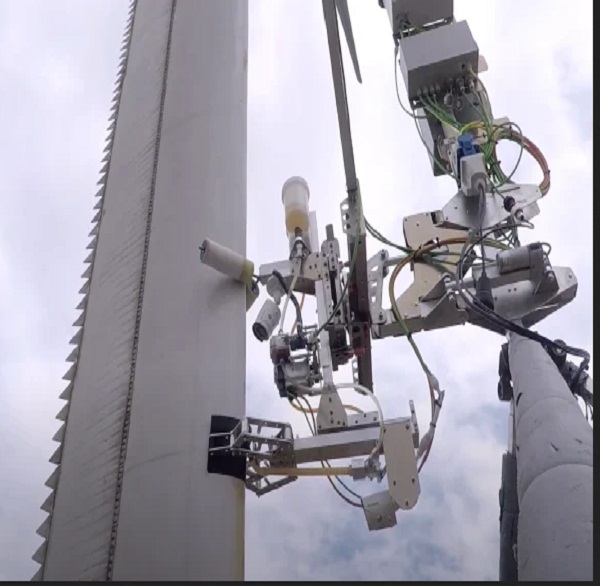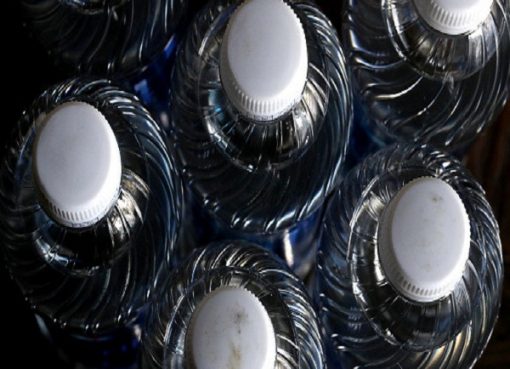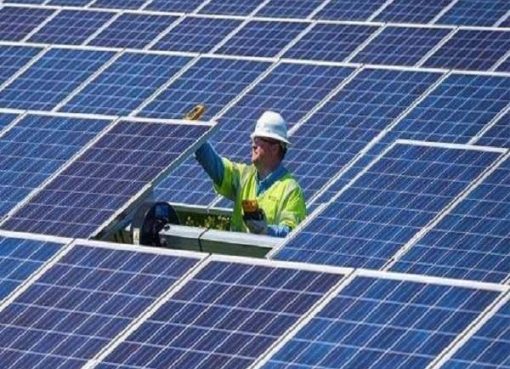Like all machinery, wind turbines require regular maintenance. Access can make this process significantly more challenging, especially as off-shore wind moves into increasingly remote deep-water sites. During a turbine’s 25- to 30-year service life, operations and maintenance can account for as much as 30 percent of the levelized cost of the electricity they provide. New robotic systems are being developed that can automate many common maintenance tasks, with a focus on leading edge inspection and repair where access is the most difficult. This is driving down the cost of wind power, enabling the technology to remain competitive as subsidies and power purchase guarantees associated with wind power are removed.
What Are the Service Requirements for Wind Turbines?
All of the major wind turbine manufacturers require mandatory annual service as part of their warranty conditions. As with any machinery, correct maintenance prevents failures that could cause secondary damage, excessive downtime and higher costs. These services consist of basic preventative maintenance and condition monitoring activities such as tightening bolts, cleaning, applying lubricant, changing oil filters, and taking oil samples. These activities, common to any rotating machinery, are largely carried out in the nacelle. Anchor bolts, located around the baseplate of the turbine, are also checked and tightened where necessary.
The amount of this type of maintenance required depends on whether the turbine is geared or direct drive. Gearboxes significantly increase the amount of regular maintenance required and the result is much longer outages if a failure does occur, often requiring several days of unplanned maintenance to get the turbine back online. The duration for these types of repairs has been increasing as wind turbines get larger.
The frequency of machine maintenance, and especially unplanned maintenance leading to downtime, can be reduced through remote condition monitoring. For example, insurance companies normally mandate that roller bearings be replaced every five years, but will allow longer intervals if condition monitoring is in place to demonstrate continued acceptable performance. The use of vibration analysis for rotating machinery is well established throughout industry. Similar methods are now also being used to “listen” for changes in the vibration from turbine blades caused by defects on the blades’ surfaces. The combination of vibrations caused by rotating machinery, wind flow disturbances and sea swell means that the standard condition monitoring methods set out in ISO 10816-3 are not relevant. Special standards have been developed to address gearbox wind turbines (ISO 10816-21: 2015) and direct drive turbines (ISO 10816-22, under development). Wind flow disturbances produce vibrations in the nacelle and tower at frequencies of between 0.1 Hz and 10 Hz, requiring sample durations of around 10 minutes. Rotating components of gearboxes and generators cause higher frequency vibrations that can be sampled within one minute, with peaks from 10 Hz to more than 1 kHz.
Other inspection and repair procedures carried out on the turbine blades have more in common with airframes than with industrial machinery. To maintain efficiency, the blades must be kept clean with smooth surfaces free of nicks and cracks. Regular cleaning and inspections are, therefore, also included in annual services. When defects are identified, closer inspection may be required before the repair is specified. Repairs typically involve grinding, filling and sanding.
Wind Turbine Blade Inspection
Inspecting turbine blades for visible damage is complicated by the size of modern turbines and the difficulty of accessing the blades. Ground-based inspection is often carried out first, using high-powered telephoto lenses combined with ultrahigh definition imaging. Ground inspection software is used to stitch together around 1,000 images, giving a complete record of a blade’s condition. This type of inspection can be conducted in almost any weather and negates the need to directly access the blade. We recently covered the Ping Monitor, a listening Internet of Things (IoT) device that can reduce the need for regular blade inspections. In light winds, a more detailed inspection can be performed using a drone. Following initial detection, it is normally necessary to carry out a manual follow-up inspection to evaluate the damage and repair required.
When performing manual inspection, rope access technicians move down a blade from the nacelle, with the blade orientated at a downward angle. The rope access technicians typically work in pairs, with ropes allowing them to descend down the blade and another rope looped around the blade to hold them against it. Technicians can then use digital cameras and laser scanners to characterize defects for engineers to access remotely. Continuity testing may also be performed to access lightning protection systems.
A blade inspection and repair robot developed by Aerones can perform the same inspection operations as a human rope access technician in a fully automated process. The robot accesses the blade in a way that is similar to how a human does, moving along a rope suspended from the nacelle. A tripod, which extends below the main body of the robot, provides stability via three ropes that extend to the ground. As the top rope moves the robot up and down, the lower three ropes are also moved to maintain a stable position and orientation of the robot. These ropes are controlled by four winches located on the ground. The operation of these ropes, as well as the inspection process itself, is all controlled by an operator inside a vehicle. The only part of the process that is not carried out from the ground is securing the anchor point for the top rope, although it is even possible to loop the rope over the nacelle using a heavy lift drone. This system is currently only suitable for onshore wind turbines.
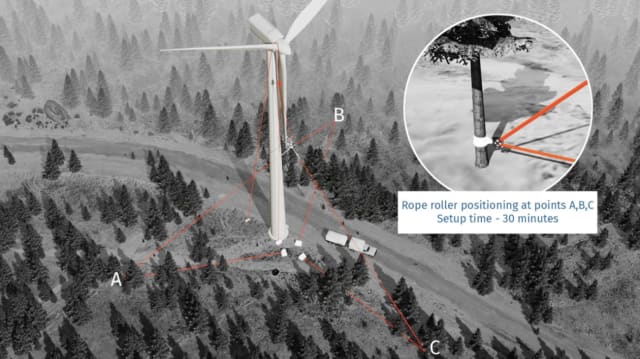
Extending from the body of the Aerones robot there is a single articulated arm. Various end effectors can be attached to this arm for performing inspection, cleaning and repair. The full range of inspection operations are possible, including visual inspection, laser scanning and conductivity testing. Internal inspection uses a more compact system with a 360-degree camera that is manually lowered down the inside of a turbine blade.
Wind Turbine Cleaning
Regular cleaning is required to maintain the smooth aerodynamic profiles of turbine blades. The same Aerones robot that is used for inspection can also be used for cleaning the turbine’s blades, towers and drainage holes. A hose extends from the ground to supply a mixture of water and biodegradable detergent. Powered rotating brushes are used to remove the buildup of dirt, insects and oil. Plastic sheeting is arranged on the ground to collect the dirty water, which will later be processed to remove the oil. Another brush is used to clean drainage holes.
Blade Repairs
Repairing defects in a turbine’s blades is vital to maintaining its efficiency. Defects typically occur along the leading edge and this is also the most critical to its performance. Repairs involve grinding and sanding, filling with resin, applying gel coat and polishing. These operations are the most challenging to automate.
Aerones robot uses rollers to precisely position and align the robot to the turbine’s leading edge. The robot performs a full leading-edge repair within two hours, involving the following process steps:
- Laser scanning to evaluate blade condition and adjust repair tools
- Grinding and sanding to remove the damaged and eroded layer
- Decontamination of the surface to allow good adhesion of the repair
- Filler application and profiling
- Laser scanning to validate repair condition
The grinding and sanding process uses belt sanders along the sides of the turbine’s leading edge and a flap-wheel sander on the leading edge itself.
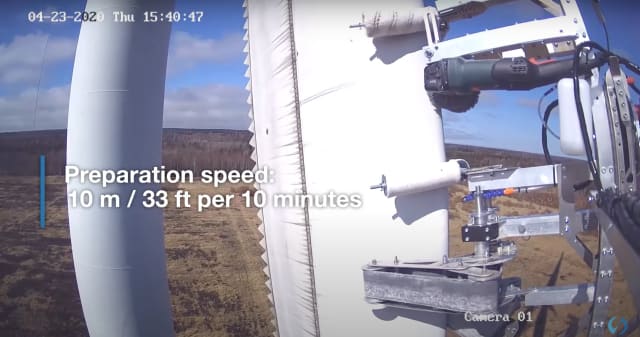
Although access to wind turbines can make maintenance challenging, a combination of remote condition monitoring and automation can make this a cost-effective operation. These trends are expected to continue, driving down the cost of renewable energy.
Source: engineering


